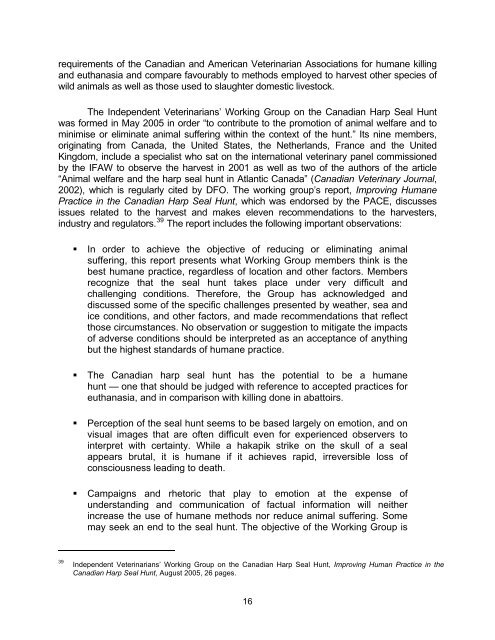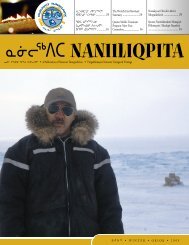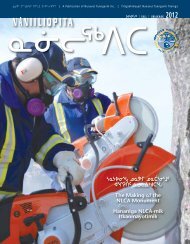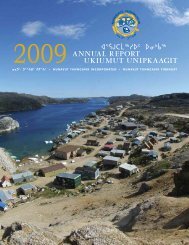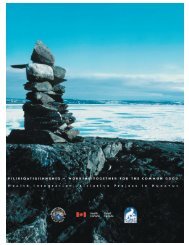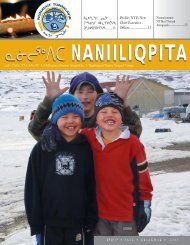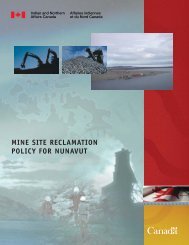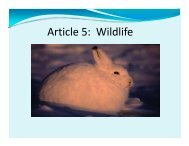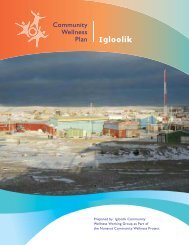Ensuring a Sustainable and Humane Seal Harvest - Nunavut ...
Ensuring a Sustainable and Humane Seal Harvest - Nunavut ...
Ensuring a Sustainable and Humane Seal Harvest - Nunavut ...
Create successful ePaper yourself
Turn your PDF publications into a flip-book with our unique Google optimized e-Paper software.
equirements of the Canadian <strong>and</strong> American Veterinarian Associations for humane killing<strong>and</strong> euthanasia <strong>and</strong> compare favourably to methods employed to harvest other species ofwild animals as well as those used to slaughter domestic livestock.The Independent Veterinarians’ Working Group on the Canadian Harp <strong>Seal</strong> Huntwas formed in May 2005 in order “to contribute to the promotion of animal welfare <strong>and</strong> tominimise or eliminate animal suffering within the context of the hunt.” Its nine members,originating from Canada, the United States, the Netherl<strong>and</strong>s, France <strong>and</strong> the UnitedKingdom, include a specialist who sat on the international veterinary panel commissionedby the IFAW to observe the harvest in 2001 as well as two of the authors of the article“Animal welfare <strong>and</strong> the harp seal hunt in Atlantic Canada” (Canadian Veterinary Journal,2002), which is regularly cited by DFO. The working group’s report, Improving <strong>Humane</strong>Practice in the Canadian Harp <strong>Seal</strong> Hunt, which was endorsed by the PACE, discussesissues related to the harvest <strong>and</strong> makes eleven recommendations to the harvesters,industry <strong>and</strong> regulators. 39 The report includes the following important observations:• In order to achieve the objective of reducing or eliminating animalsuffering, this report presents what Working Group members think is thebest humane practice, regardless of location <strong>and</strong> other factors. Membersrecognize that the seal hunt takes place under very difficult <strong>and</strong>challenging conditions. Therefore, the Group has acknowledged <strong>and</strong>discussed some of the specific challenges presented by weather, sea <strong>and</strong>ice conditions, <strong>and</strong> other factors, <strong>and</strong> made recommendations that reflectthose circumstances. No observation or suggestion to mitigate the impactsof adverse conditions should be interpreted as an acceptance of anythingbut the highest st<strong>and</strong>ards of humane practice.• The Canadian harp seal hunt has the potential to be a humanehunt — one that should be judged with reference to accepted practices foreuthanasia, <strong>and</strong> in comparison with killing done in abattoirs.• Perception of the seal hunt seems to be based largely on emotion, <strong>and</strong> onvisual images that are often difficult even for experienced observers tointerpret with certainty. While a hakapik strike on the skull of a sealappears brutal, it is humane if it achieves rapid, irreversible loss ofconsciousness leading to death.• Campaigns <strong>and</strong> rhetoric that play to emotion at the expense ofunderst<strong>and</strong>ing <strong>and</strong> communication of factual information will neitherincrease the use of humane methods nor reduce animal suffering. Somemay seek an end to the seal hunt. The objective of the Working Group is39Independent Veterinarians’ Working Group on the Canadian Harp <strong>Seal</strong> Hunt, Improving Human Practice in theCanadian Harp <strong>Seal</strong> Hunt, August 2005, 26 pages.16


